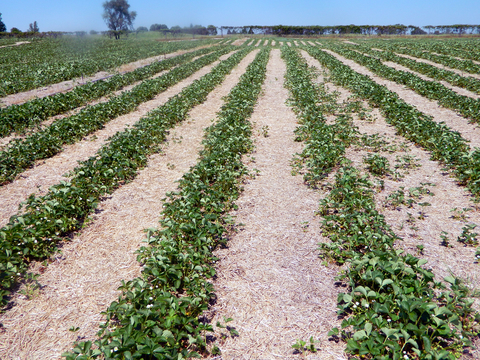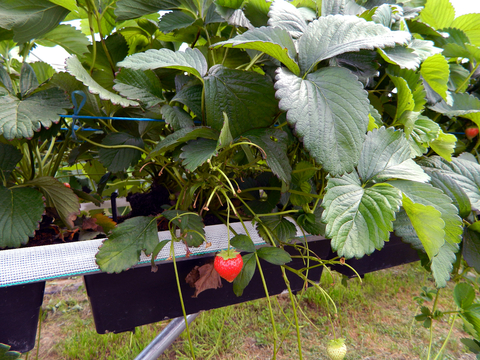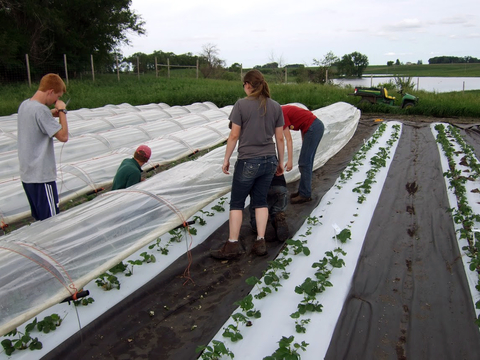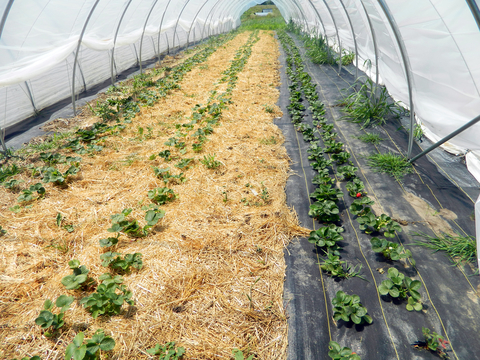Key points
- There are two types of strawberries grown in Minnesota: June-bearing and day-neutral.
- June-bearing strawberries are grown on straw and are perennial.
- Day-neutral strawberries are grown on plastic, usually under protected culture, and are usually grown as annuals.
- They have distinct requirements, harvest seasons, and other characteristics, but share insect pests and diseases.
There are two types of strawberries used in cold climate commercial production: June-bearing and day-neutral.
These are different varieties grown in distinctly different systems with different management requirements and harvest times. While June-bearing strawberries are typically grown on matted rows with straw, day-neutral strawberries are most often grown on raised beds covered with plastic. They share some requirements, such as pest management and nutrient needs.
June-bearing strawberries
- Harvested for 3 to 5 weeks, from late June to mid-July.
- Perennial: grown for 3 to 5 years before being removed and replaced with new plants.
- Most productive in the second, third, and fourth years after planting.
- Grown on matted rows with straw mulch.
- Covered with straw over the winter.
- Must be renovated each season immediately after harvest. Renovation includes mowing down old leaves, controlling weeds and fertilizing the plants so they regrow vigorously before winter.
- Reproduce via runners that allow them to expand into dense, wide rows.
Day-neutral strawberries
- Typically grown as annuals: removed and replaced every year.
- Although they can technically survive for more than one year, they are usually most productive and disease-free in the first season, so they are replanted every year.
- Produce fruit for about 14 weeks from July to October in Minnesota.
- Produce significantly higher yields than June-bearing strawberries.
- Usually grown on plastic mulch under low tunnels, but can also be grown in caterpillar tunnels, high tunnels, tabletop gutters, or in open field settings.
- Highest yields are achieved on plastic mulch under low tunnels.
- Tabletop day-neutral strawberry systems are still being developed and tested in Minnesota.
- Runners must be removed from day-neutral strawberries since they serve no purpose in this system. If runners are left, they take energy away from fruit production.
More information on day-neutral strawberry production.
| June-bearing varieties in matted rows | Day-neutral strawberries |
|---|---|
| June-bearing cultivars | Day-neutral cultivars |
| Grown in an open field on flat rows or slightly raised beds with no plastic mulch (to allow rooting of daughter plants). | Best grown on raised beds with plastic mulch and either high tunnels or low tunnels. |
| Harvest in June to early July. | Harvest from mid-July through early October. |
| Planted in early Spring. | Planted in early spring. |
| Plants can stay in the ground 3–4 years. | Plants are replaced every year. |
| 2–3 acres are sufficient for a small operation. | A few rows can offer high yields of extended-season fruit. |
| 4000–9000 plants/ac, depending on spacing. | 200 plants per 100 feet of row, or about 17,500 plants/ac, depending on row spacing. |
| Primary costs include plants, straw mulch, irrigation, labor. | Primary costs include plants, plastic mulch, tunnel materials, irrigation, labor. |
| Weeds can be a major challenge. | Weeds are minimal due to plastic mulch. |
| Produce fruit one year after planting. | Produce fruit during year of planting only. |
| 3–4 years of production from planting. | One year of production from planting. |
| Average to high market value. | High market value because system facilitates organic and extended-season production. |
| Yield up to 7000 lbs/acre. | While the results are still preliminary, studies have shown a yield up to 20,000 lbs/acre. |
Reviewed in 2021





